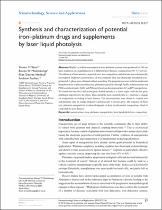 ResearchSpace
ResearchSpace
Synthesis and characterization of potential iron–platinum drugs and supplements by laser liquid photolysis
JavaScript is disabled for your browser. Some features of this site may not work without it.
- ResearchSpace
- →
- Research Publications/Outputs
- →
- Journal Articles
- →
- View Item
| dc.contributor.author |
Nkosi, SS

|
|
| dc.contributor.author |
Mwakikunga, Bonex W

|
|
| dc.contributor.author |
Sideras-Haddad, E

|
|
| dc.contributor.author |
Forbes, A

|
|
| dc.date.accessioned | 2013-11-25T12:56:49Z | |
| dc.date.available | 2013-11-25T12:56:49Z | |
| dc.date.issued | 2013-06 | |
| dc.identifier.citation | Nkosi, S.S, Mwakikunga, B.W, Sideras-Haddad, E and Forbes, A. 2013. Synthesis and characterization of potential iron–platinum drugs and supplements by laser liquid photolysis. Nanotechnology, Science and Application, vol. 5, pp 27-36 | en_US |
| dc.identifier.issn | 1177-8903 | |
| dc.identifier.uri | http://www.ncbi.nlm.nih.gov/pmc/articles/PMC3781719/ | |
| dc.identifier.uri | http://hdl.handle.net/10204/7093 | |
| dc.identifier.uri | doi: 10.2147/NSA.S24419 | |
| dc.description | Copyright: 2013 Dove Medical Press. This is an open access journal. Published in Nanotechnology, Science and Application, vol. 5, pp 27-36 | en_US |
| dc.description.abstract | Highly crystalline nanospherical iron–platinum systems were produced by 248 nm laser irradiation of a liquid precursor at different laser fluences, ranging from 100–375 mJ/cm2. The influence of laser intensity on particle size, iron composition, and structure was systematically investigated. Different nanostructures of iron–platinum alloy and chemically disordered iron–platinum L10 phase were obtained without annealing. The prepared precursor solution underwent deep photolysis to polycrystalline iron–platinum nanoalloys through Fe(III) acetylacetonate and Pt(II) acetylacetonate. Fe(II) and Pt(I) acetylacetone decomposed into Fe0 and Pt0 nanoparticles. We found that the (001) diffraction peak shifted linearly to a lower angle, with the last peak shifting in opposition to the others. This caused the face-centered cubic L10 structure to change its composition according to laser fluence. The nanostructures were shown to contain iron and platinum only by energy-dispersive spectroscopy at several spots. The response of these iron–platinum nanoparticles to infrared depends on their stoichiometric composition, which is controlled by laser fluence. | en_US |
| dc.language.iso | en | en_US |
| dc.publisher | Dove Medical Press | en_US |
| dc.relation.ispartofseries | Workflow;11304 | |
| dc.subject | Nanostructures | en_US |
| dc.subject | Iron–platinum drugs | en_US |
| dc.subject | Iron | en_US |
| dc.subject | Platinum | en_US |
| dc.subject | Nanoparticles | en_US |
| dc.subject | Laser liquid photolysis | en_US |
| dc.subject | Iron–platinum alloy | en_US |
| dc.title | Synthesis and characterization of potential iron–platinum drugs and supplements by laser liquid photolysis | en_US |
| dc.type | Article | en_US |
| dc.identifier.apacitation | Nkosi, S., Mwakikunga, B. W., Sideras-Haddad, E., & Forbes, A. (2013). Synthesis and characterization of potential iron–platinum drugs and supplements by laser liquid photolysis. http://hdl.handle.net/10204/7093 | en_ZA |
| dc.identifier.chicagocitation | Nkosi, SS, Bonex W Mwakikunga, E Sideras-Haddad, and A Forbes "Synthesis and characterization of potential iron–platinum drugs and supplements by laser liquid photolysis." (2013) http://hdl.handle.net/10204/7093 | en_ZA |
| dc.identifier.vancouvercitation | Nkosi S, Mwakikunga BW, Sideras-Haddad E, Forbes A. Synthesis and characterization of potential iron–platinum drugs and supplements by laser liquid photolysis. 2013; http://hdl.handle.net/10204/7093. | en_ZA |
| dc.identifier.ris | TY - Article AU - Nkosi, SS AU - Mwakikunga, Bonex W AU - Sideras-Haddad, E AU - Forbes, A AB - Highly crystalline nanospherical iron–platinum systems were produced by 248 nm laser irradiation of a liquid precursor at different laser fluences, ranging from 100–375 mJ/cm2. The influence of laser intensity on particle size, iron composition, and structure was systematically investigated. Different nanostructures of iron–platinum alloy and chemically disordered iron–platinum L10 phase were obtained without annealing. The prepared precursor solution underwent deep photolysis to polycrystalline iron–platinum nanoalloys through Fe(III) acetylacetonate and Pt(II) acetylacetonate. Fe(II) and Pt(I) acetylacetone decomposed into Fe0 and Pt0 nanoparticles. We found that the (001) diffraction peak shifted linearly to a lower angle, with the last peak shifting in opposition to the others. This caused the face-centered cubic L10 structure to change its composition according to laser fluence. The nanostructures were shown to contain iron and platinum only by energy-dispersive spectroscopy at several spots. The response of these iron–platinum nanoparticles to infrared depends on their stoichiometric composition, which is controlled by laser fluence. DA - 2013-06 DB - ResearchSpace DP - CSIR KW - Nanostructures KW - Iron–platinum drugs KW - Iron KW - Platinum KW - Nanoparticles KW - Laser liquid photolysis KW - Iron–platinum alloy LK - https://researchspace.csir.co.za PY - 2013 SM - 1177-8903 T1 - Synthesis and characterization of potential iron–platinum drugs and supplements by laser liquid photolysis TI - Synthesis and characterization of potential iron–platinum drugs and supplements by laser liquid photolysis UR - http://hdl.handle.net/10204/7093 ER - | en_ZA |





